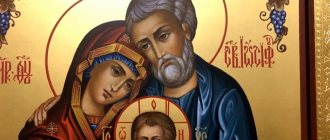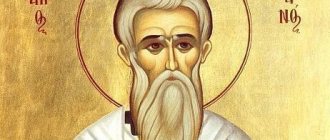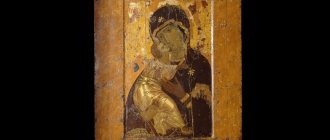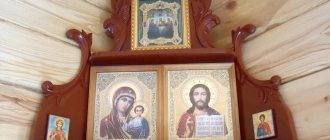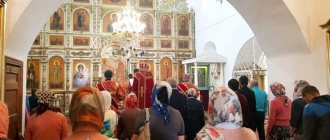Having seen the Resurrection of Christ. Prayer-hymn for Easter. Voice 6.
Having seen the Resurrection of Christ, let us worship the holy Lord Jesus, the only sinless one. We worship Thy Cross, O Christ, and we sing and glorify Thy holy resurrection: for Thou art our God, do we know no other to Thee, we call Thy name. Come, all faithful, let us worship the holy resurrection of Christ: behold, joy has come through the Cross to the whole world. Always blessing the Lord, we sing of His resurrection: having endured crucifixion, destroy death by death.
Job rating: 15
Number of reviews:
3
Number of posts:
4
Number of views:
472
© 03/22/2018 Galina Lebedinskaya Certificate of publication:
izba-2018-2230862
Galina Lebedinskaya 03/24/2018 05:44:56
This is the motive after the troparion “Christ is risen. "and "The Resurrection of Christ" is sung constantly at church services by Orthodox Christians together with the clergy. In the meantime, the Great One is coming. The last days are strict, and just before Easter there will be Holy Week, very strict. With gratitude and respect, - Galina.
Hayat Yakhina 03/23/2018 21:03:35 Review: positive How many centuries have passed, and God’s Word still remains the wise Truth, .. And prayers to the Holy Mother of God really help. The light of the All-Seeing Eye and His Divine Love and Grace to all! Amen
Galina Lebedinskaya 03/24/2018 05:49:40
I perceive your spiritual visits with a feeling of warmth, dear Hayat! With constant sympathy and cordiality of heart to you, - Galina.
Tatyana Falaleeva 2 03/23/2018 16:03:57 Review: positive I am amazed at the greatness of Christ. Sometimes my soul feels so strange and heavy. And if I turn to Him, what is called Darkness brightens around me. And I think about others: to whom, if not to the Lord, should a person who is tormented by his life turn? True, one must live by this name without stopping. Then the pain is moderated, and the goal is ahead, like a clear sun. He himself is our Sun.
Galina, THANK YOU. Your Tatyana.
Galina Lebedinskaya 03.23.2018 16:13:25
We only rely on the Lord, Tanya! Exactly 10 years ago I wrote about the Lord, about how He is constantly in my soul (about the Jesus Prayer):
I always hold on to the Lord: I repeat my prayer, So that trouble does not creep in, I hold on to the Lord.
The Lord gave that prayer to Me deeply in my heart, and the Call to Him began to appear easily on my lips:
"Oh my God! Save, Christ! Jesus, Son of God! — That call has grown firmly into my soul and into my heart too.
I repeat to myself everywhere: “Jesus, Son of God! Save me! - I repeat lovingly. “You are not dearer to me!”
I always hold on to the Lord: I say that prayer, So that trouble does not creep up, - I thank you for everything.
I hug you, my dear, with tenderness. Guardian Angel! 02/20/2008
In Orthodoxy, prayer in honor of the resurrection of Christ is considered one of the most important. It does not contain a request, but was created to glorify Jesus, who, having experienced the death of the body, rose from the dead. The text of the prayer is solemnly sung at every Sunday all-night liturgy after the beginning of Easter.
The Importance of the Resurrection
The Resurrection of Christ is a very significant event for all Christian people. From the moment of this event, modern chronology begins. From the moment the apostles found the Holy Sepulcher empty, a new page in history began. By His resurrection, Christ showed people the miracle of eternal life.
When they say a prayer
Those who see the text of the prayer of the resurrection of Christ sing in churches at Easter services, on certain days and time periods. At home, you can also recite the text as a form of praise to the Lord.
How to read a prayer
The words of the prayer, contrary to expectations, are not read, but are sung to the tune of the sixth voice. This is a certain church chant; everyone who constantly participates in divine services knows it.
Why do Christians honor the Cross?
The hymn contains the words “We worship Thy Cross, O Christ.” It would seem, why elevate the shameful instrument of execution so much? This was how it was before the Resurrection of Christ. Then it turned into a symbol of victory over death. Christians wear a cross like:
- a sign of belonging to faith in the Son of God;
- a symbol and weapon of protection from the devil's machinations;
- sermon testimony.
During the time of persecution of Christians, in Rome there was a peculiar type of execution: prisoners in the circus arena were given to be eaten by hungry lions. Being on the verge of death, they fearlessly preached faith in Christ, the Resurrection and eternal life. Going to the torment, they testified that they were dying for the Truth, not fearing death, for they would still come to life. Seeing such determination, many pagans followed their example, becoming Christians.
Then the tongues of those doomed to a terrible execution began to be cut out. Confessors of Christ, so as not to be confused with murderers who were subjected to the same punishment, unable to speak, showed by signs why they were going to death. They depicted the symbol of the Cross: crossing their arms on their chest or above their heads; They depicted it from sticks that were found under their feet. Thus, the sermon still “sounded.”
Note: The miracle of the discovery of the Life-Giving Cross of the Lord by the mother of the Roman Emperor Constantine, St. Helen, when the dead were resurrected, leaves no doubt that Christians worship not the instrument of death, but the triumph of victory over it.
Read the text of the prayer “Having seen the Resurrection of Christ” in Russian with accents
It is believed that the words of the prayer appeared in the period from 335 to 614. At this time, the construction of the Church of the Holy Sepulcher was completed. Later, during the Persian invasion, the Cross was removed from it. In 603 it was returned, but a few years later it was taken out of the eternal city forever. What exact event is associated with the appearance of the chant, and who first uttered it is unknown.
Prayer text
Having seen the Resurrection of Christ, let us worship the Holy Lord Jesus, the only sinless one. We worship Your Cross, O Christ, and we sing and glorify Your holy Resurrection: for You are our God, do we know no other to You, we call Your name. Come, all you faithful, let us worship the Holy Resurrection of Christ: behold, through the Cross joy has come to the whole world. Always blessing the Lord, we sing His Resurrection: having endured the crucifixion, destroy death by death.
The chant is of ancient origin and has an analogue in the text of the Western liturgy of Good Friday: “ We worship Thy Cross, O Christ, and St. We praise and glorify Your resurrection, for through the Cross came joy to the whole world
" [3] Initially, the song belonged to the Easter service, but already in the Easter Jerusalem “Sequence” of the 9th century this song is given as a Sunday song after the reading of the Gospel. The chant is clearly of Jerusalem origin (“let us worship the Holy Resurrection of Christ” - a reference to the Church of the Holy Sepulcher, frequent references to the Cross kept in the temple). [3]
The song “The Resurrection of Christ” is already mentioned in liturgical monuments of the Studio period. [4] However, in the oldest handwritten Studio Rules it is present as a hymn for Sunday Matins, but not after the Gospel reading (immediately after the reading, according to the Studio Rule, the prokeimenon is placed).
There are known author's works based on the text of the chant “Having seen the Resurrection of Christ...”: the everyday version of A. A. Arkhangelsky, the tune of P. G. Chesnokov, original compositions by A. L. Vedel, A. T. Grechaninov, S. V. Rachmaninov, P. I. Tchaikovsky and others. [4]
Baptism is a ticket to eternal life
The Lord said that only those who have faith and are baptized with water and the Holy Spirit will enter the Kingdom of God. At this moment, a person is completely cleansed of the original sin of Adam (which brings death), and a new one is born - a joint heir of Christ and His Resurrection. No one saw how the process of transfiguration of the dead body of the Lord took place. But we sing “having seen”, for we can:
- Communicate with Him in prayer.
- Feel and see His help.
- Unite with Him in Communion, approaching the Eucharistic Cup.
- To be cleansed of the sinful component in the Sacraments given by the Church.
- Receive Grace, acquire the Holy Spirit.
- See His Power, which is inherent in saints.
About 150 people witnessed the ascension of Christ, including 11 apostles, who gave their lives to bring the good news of the Resurrection to all nations. Will a person (and more than one) die for the Truth, preaching it, if he has not seen Him with his own eyes? No. Therefore, we believe them; many are convinced of the truthfulness of their words through experience and irrevocability.
St. Maximus the Confessor: “He who knows the mystery of the cross and the tomb will also know the essential meaning of all things... He who penetrates even deeper than the cross and the tomb, and is initiated into the mystery of the resurrection, will know the ultimate purpose for which God created all things.”
Liturgical use
The chant “Having seen the Resurrection of Christ” is used during divine services: [4]
On Easter, Easter week and Sundays from Easter to Ascension, the song is sung three times. On other days - once. In addition, the chant is included in the rite of the Easter funeral service. [5]
In the Greek practice of the 16th century, the chant “Having seen the Resurrection of Christ...” was performed by the singing brethren. Arseny (Sukhanov) (XVII century) writes that in Greek churches the chant “ was spoken in both faces, divided by lines
" In modern Greek worship, “Having seen the Resurrection of Christ...” is read by the primate (the abbot or bishop standing in the choir) or the reader.
In modern liturgical practice of the Russian Orthodox Church, the chant “Having seen the Resurrection of Christ...” is usually performed by all believers in the 6th tone.
history of the holiday
Easter is the oldest holiday of the Christian Church. It was established and celebrated already in apostolic times. Probably, the circle of holidays of the Ancient Church until the century was limited to Sunday. Hardly in the words of the ap. Paul: “Our Passover, Christ was devoured for us; by the same token, let us not celebrate with kvass” (1 Cor. 5:7-8) one can see an indication of the Christian Easter as opposed to the Jewish one. Rather, such an indication can be seen in the care with which St. John the Theologian notes the coincidence of the death of Christ with the Jewish Passover (John 19:4; John 18:28. Compare John 13:1). The insistence with which Christian tradition has always attributed the establishment of Great Lent to the apostles themselves allows us to look for at least its beginnings in that time. It is possible that the words of the Savior: “When the bridegroom is taken away from them, then they fast,” cited by Tertullian as a possible basis for Great Lent, were understood in this sense by the apostles themselves and encouraged them to annually sanctify fasting, which they generally loved (Acts 13 ,2), the day of the death of the Lord. Since this day fell on the Jewish Passover, when the observance of Jewish holidays ceased among Christians, the latter could easily come to the idea of sanctifying the day of the Jewish Passover with fasting in remembrance of the death of Christ. Easter of Christ originally existed in the form of such fasting, as can be seen from the testimony of St. Irenaeus of Lyons (c.).
| The appearance of Christ to the disciples in the village of Emmaus, Refectory Church, Kiev Pechersk Lavra |
Even in the 3rd century.
Christian Easter was reduced to fasting, it was “Easter of the Cross”, along with which Easter of the Resurrection had just begun to act as an independent holiday - under the guise of the solemn end of the Easter fast. During the time of the apostles, this fast was probably left by some on the very day of Passover, and by others on the following Sunday. According to Socrates (5th century), Christians who celebrated Easter on the 14th day of the month of Nisan (i.e. on the same day as the Jews) claimed that this was handed down to them from the Apostle John, and those who celebrated Easter on the following day Easter Sunday they said that they received their custom from St. Peter and Paul. “But neither one nor the other,” notes the ancient historian, “can provide written evidence of this” [2].
In this regard, an important passage from the letter of St. Irinea, bishop Lyonsky, to the Roman bishop. Victor, preserved by Eusebius of Caesarea. It sheds light on the original nature of the Easter holiday. The message was written regarding the disputes about the time of celebrating Easter, which began during the reign of St. Polycarpe, bishop Smyrna (+167), which caused a series of councils and continued with even greater force under St. Irenaeus (+ 202). The disputes concerned the question: to celebrate Easter together with the Jewish one (on the 14th - 15th day of the first spring lunar month) or on the first Sunday after this day.
Excerpt from the text of St. Irenea shows that the dispute about the time of Easter arose because by this time the nature of the holiday itself and the view of it gradually began to change. If earlier Easter was looked upon as a fast in honor of the death of the Savior, who died precisely on the day of the Jewish Passover, now they wanted to combine with it the joyful memory of the Resurrection of Christ, which could not be combined with fasting and was more suitable not for any day of the week, but for which fell on the Jewish Passover, and on Sunday.
In Rome, Easter of Christ began to acquire this character very early, while in Asia Minor church life did not move with such speed, and the original ancient view of Easter remained longer. Therefore, the bishops of the West and the East simply did not understand each other.
| Resurrection of Christ |
St. Irenaeus of Lyons wrote: “They disagree not only about the day, but also about the very image of fasting (a clear indication that the “day”, i.e. Easter, was honored and celebrated precisely by fasting - note by M. Skaballanovich);
It is precisely some who think that you need to fast only one day, others two days, others even more; some calculate their day at 40 hours of day and night. Such a difference in observance did not occur in our time, but much earlier among our ancestors, who probably did not observe great precision in this and passed on their simple, private custom to their offspring. Nevertheless, they all maintained peace, and we live in peace among ourselves, and disagreement regarding fasting (again, not a “holiday”) affirms the agreement of faith” [3]. To this passage from St. Irenaeus Eusebius adds his story about the dispute regarding Easter at St. Polycarpe, when, during the latter’s visit to the Roman bishop. Anikita, their disagreement became clear both on this issue and on others, then “both of them did not argue much with each other regarding other subjects, but immediately agreed, but they did not want to argue about this issue, because neither Anikita could to persuade Polycarp not to observe what he had always observed while living with John, the disciple of our Lord; Neither Polycarp convinced Anicetas to observe, for Anicetas said that he was obliged to preserve the customs of the presbyters who preceded him.”
After St. Polycarp's defender of Asia Minor practice regarding the time of Easter was Melito, bishop. Sardinian, who wrote “Two Books of Easter” (c. 170). Her (literary) opponents were Apollinaris, Bishop. Hierapolis, Clement of Alexandria and St. Hippolytus, Bishop Roman. Councils were held in Palestine, Rome, Pontus, Gaul and Greece in favor of Roman practice. Pope Victor (c. 196) threatened the people of Asia Minor with excommunication. The mentioned message of St. Irenaeus had the goal of reconciling the warring parties. Apparently, the dispute continued until the Council of Nicaea (325), which adopted the Roman practice as universal. The council's definition of Easter has not reached us. Since ancient times, Orthodox Local Churches have determined the date of Easter celebration according to the so-called Alexandrian Paschal: on the first Sunday after the Paschal full moon, between March 22 and April 25.
In 341, the Council of Antioch ordered the excommunication from the Church of “those who celebrate Easter with the Jews” (Canon 1). The custom of fasting on Easter is also exposed by St. John Chrysostom.

